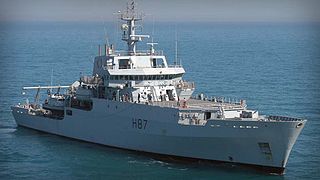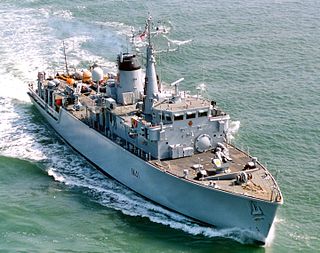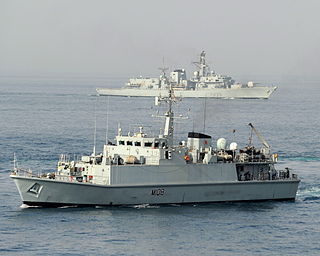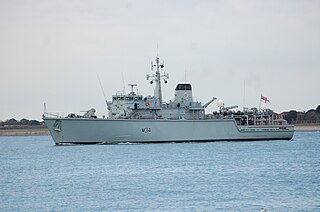
The Echo class was a class of multi-purpose hydrographic survey ships in commission with the Royal Navy. The ships were primarily tasked with conducting survey work in support of submarine and amphibious operations, however, the class also has a secondary role in mine countermeasures. The two vessels of the class were the most recent additions to the Royal Navy's Hydrographic Squadron. Each ship displaced approximately 3,700 tonnes, and was equipped with a state of the art suite of equipment. The lead ship of the class, HMS Echo, was retired in 2022 and her sister ship in 2023.

HMS Quorn, the third ship of this name, was a Hunt-class mine countermeasures vessel of the Royal Navy. She was launched on 23 January 1988, as the last ship of her class.

The Hunt class is a class of thirteen mine countermeasure vessels of the Royal Navy. As built, they combined the separate roles of the traditional minesweeper and that of the active minehunter in one hull, but later modifications saw the removal of mine-sweeping equipment. They have a secondary role as offshore patrol vessels.

The Sandown class is a class of fifteen minehunters built primarily for the Royal Navy by Vosper Thornycroft. The Sandown class also serve with the Royal Saudi Navy, the Estonian Navy, and the Ukrainian Navy. The first vessel was commissioned into Royal Navy service on 9 June 1989 and all the British ships were named after coastal towns and cities. Although the class had a primary mine countermeasures role, they have had a secondary role as offshore patrol vessels. As of early 2024, only one vessel of the class remains in active service with the Royal Navy.

The Commander-in-Chief Fleet (CINCFLEET) was the admiral responsible for the operations of the ships, submarines and aircraft of the British Royal Navy from 1971 until April 2012. The post was subordinate to the First Sea Lord, the professional head of the Naval Service. In its last years, as the Navy shrank, more administrative responsibilities were added.

HMS Bronington is a former Ton-class minesweeper of the Royal Navy, named HMS Humber between 1954 and 1958. This mahogany-hulled minesweeper was one of the last of the wooden-hulled naval vessels. Decommissioned in 1988, she was subsequently a museum ship, but sank at Birkenhead in 2016.

HMS Tyne is a River-class offshore patrol vessel built by Vosper Thornycroft in Southampton for the Royal Navy to serve as a fishery protection unit within the United Kingdom's waters along with her two sister ships Mersey and Severn. All three were commissioned into service in 2003 to replace the five older Island-class patrol vessels.

The Ton class were coastal minesweepers built in the 1950s for the Royal Navy, but also used by other navies such as the South African Navy and the Royal Australian Navy. They were intended to meet the threat of seabed mines laid in shallow coastal waters, rivers, ports and harbours, a task for which the existing ocean-going minesweepers of the Algerine class were not suited.

HMS Bangor is a Sandown-class minehunter commissioned by the Royal Navy in 2000. Designed to hunt naval mines in depths of up to 200 m (660 ft) using the Sonar 2093 Variable Depth Sonar (VDS) meaning that she can conduct mine clearance operations throughout the continental shelf. She is named after the Northern Ireland seaside city of the same name, and the second Royal Navy vessel to bear the name. As of January 2024, she was the last vessel of her class in active Royal Navy service.
The Northern Ireland Squadron was a unit of the British Royal Navy. It was established during the conflict in Northern Ireland known as the Troubles to interdict the movement by sea of illegal arms for paramilitaries and to provide other material support for anti-terrorist operations in Northern Ireland. It existed from 1969 to 1998.

HMS Grimsby was a Sandown-class minehunter of the British Royal Navy, serving from 1999–2022, and the second ship to bear the name.

HMS Ledbury, the second ship of the name, is a Hunt-class mine countermeasures vessel of the Royal Navy. She was launched in December 1979 and commissioned on 11 June 1981, the second ship of her class. She cost £65 million at time of building, which was at the time the most expensive cost-per-metre for any class of ship built by the Royal Navy. Most of this cost went into the research and development of Ledbury's glass reinforced plastic hull.

HMS Penzance was a Sandown-class minehunter commissioned by the Royal Navy in 1998. She was named after the seaside town of Penzance in Cornwall, and was the fourth vessel to bear the name. She was decommissioned in January 2024.

Sublocotenent Ion Ghiculescu (M270) is a Sandown-class minehunter of the Romanian Naval Forces. She was built as HMS Blyth (M111), for the Royal Navy, the eleventh of this class of twelve Single-Role Minehunters (SRMH) ships. She was laid down on 30 May 1999 by Vosper Thornycroft at their Woolston, Southampton shipyard, launched in May 2000 and entered service for the Royal Navy in February 2001. She was the second vessel to carry this name, the first being a Bangor-class minesweeper of the Second World War, wearing pennant number J15. Blyth served in the Middle East as part of the 9th Mine Countermeasures Squadron.

HMS Shoreham was a Sandown-class minehunter of the British Royal Navy. She was the fifth vessel to bear the name. From 2018 to 2021, Shoreham was deployed at UKNSF Bahrain together with three other mine countermeasures ships as part of 9 Mine Countermeasures Squadron on Operation Kipion. In 2022 she was decommissioned and was transferred to Ukraine.

HMS Brocklesby is a Hunt-class mine countermeasures vessel of the British Royal Navy, her primary purpose is to find and neutralise sea mines using a combination of; Sonar, Mine Clearance Divers and the Seafox remotely operated vehicle (ROV). The class are the largest warships of glass-reinforced plastic (GRP) construction, which gives the vessels a low magnetic signature. In addition to her mine countermeasures activities, Brocklesby acts as an offshore patrol vessel, undertaking coastal patrol and fisheries protection duties.

HMS Middleton is a Hunt-class mine countermeasures vessel of the British Royal Navy. As of 2021, she forms part of 9th Mine Countermeasures Squadron operating out of HMS Jufair in Bahrain.
In 1989 the Royal Navy was under the direction of the Navy Department in the UK Ministry of Defence. It had two main commands, CINCFLEET and Naval Home Command.
Junella was a fishing trawler, best known for her service with the Royal Navy during the Falklands War. She was built in 1975 for J Marr & Son, a Hull-based fishing company. On 11 April 1982 she was taken up from trade by the British government and commissioned into the Royal Navy. She was fitted with Second World War era minesweeping gear at Rosyth Dockyard, manned by Royal Navy sailors and allocated to the 11th Mine Countermeasures Squadron. She sailed on 26 April but was unable to commence sweeping until after the 14 June Argentine surrender. In the meantime she was utilised to transfer troops and stores between ships and landed special forces troops at San Carlos. Demining operations commenced on 21 June. Junella returned to the United Kingdom on 11 August, carrying a defused Argentine mine.















